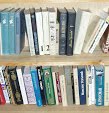 Benjamin Stein’s The Canvas, which I read in Brian Zumhagen’s translation of the German novel
known as Leinwand, is a book where I
literally wasn’t always sure which side was up or down: the book is structured,
physically, as two books in one, and each book-side is narrated by a main
character. The reader is presented with the choice of either reading each story
individually or flipping the book, chapter by chapter, and watching the two
stories intersect.
Benjamin Stein’s The Canvas, which I read in Brian Zumhagen’s translation of the German novel
known as Leinwand, is a book where I
literally wasn’t always sure which side was up or down: the book is structured,
physically, as two books in one, and each book-side is narrated by a main
character. The reader is presented with the choice of either reading each story
individually or flipping the book, chapter by chapter, and watching the two
stories intersect.
I chose the second option and used a magnetic bookmark. I
began—randomly, I think—on the side narrated by Jan Wechsler (Europublisher who
receives a mysterious bag of stuff he thinks just can’t possibly be his), then switched
over to Amnon Zichroni (an Israel-born psychic of sorts who moves around)… and
back again, chapter by chapter, until their stories met in the middle. In
Israel.
If I had to summarize the wonderfully complex The Canvas in one awkwardly simplistic
phrase, I think I’d say something like “existential confusion, nicely rendered.” The Canvas looks at some of my favorite
topics—identity, memory, (ir)reality, and how they all fit together—and makes
them exponentially more complicated and relevant by placing them within present-day
historical memory of the Holocaust and, in particular detail, Jewish identity. Historical
memories float to the surface of The
Canvas in the person of a shadowy violin restorer and memoirist named Minsky,
a character modeled on Binjamin Wilkomirski,
a real-life (our life!) writer who fabricated a Holocaust memoir in the 1990s. Meaning
we have fact/fiction and fact/fiction in The
Canvas. These lines, from Jan Wechsler, concisely sum up a lot about the
book, “Cultivating fables is complicated. You need a good memory. Otherwise,
you’re sunk.”
I found Amnon Zichroni’s half of the book more interesting
than Wechsler’s, though, and not just because Zichroni lives in Portland,
Maine, for a while, where he does a residency in psychiatry at Maine Medical
Center, a hospital where I used to work as a medical interpreter. Zichroni’s skills
include using touch to read into people’s pasts, and his single-day reading of
Mikhail Bulgakov’s Master and Margarita
is a touchstone in his half of the book. Zichroni refers to chains of events
and determinism in one long paragraph that references M&M. Here’s the second half of the paragraph:
I knew that Annouchka had already spilled the sunflower oil. And it really almost drove me out of my mind that I didn’t have the slightest idea how to save Berlioz from losing his head when he so persistently refused to at least accept that something else was directing people’s lives—namely, the sometimes grim, poetic hand of Hashem.
That’s particularly lovely stuff—Annouchka and that damn
sunflower oil all over again!—if you’ve read M&M,
another novel, by the way, that blends distinct story lines and questions of
faith.
Oddly, I think the physical layout of the book called The Canvas, with its demand that the reader
flip back and forth, is one of the reasons the novel works. Though it would be
easy to say the flipping felt like a cheap gimmick and annoyed me a reader, I think
the flipping reinforces, through the actual physical action of turning the book,
physical aspects of identity, location, and, well, which end is up, all of
which are important themes in a novel that I read as an existential
thriller. The Canvas read smoothly enough
in Zumhagen’s translation that the novel could feel like a thriller with
consistent voices. The book contains a glossary of Jewish and Yiddish terms, twice,
once at the end of each man’s story. It’s very fitting to offer those words at the
heart of the novel, back-to-back, facing two ways.
Disclosures: I
received a review copy of The Canvas
from Open Letter, a publisher with which I always enjoy discussing literature
in translation, including a specific piece I’m translating.
Up Next: Orly Castel Bloom’s horribly, hilariously demented
Dolly City.

No comments:
Post a Comment